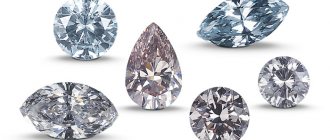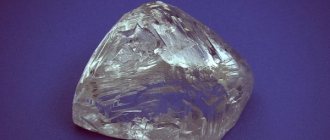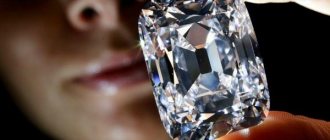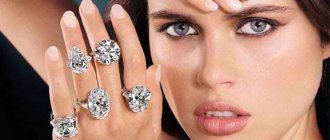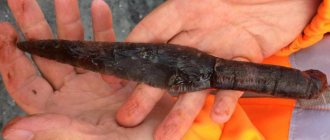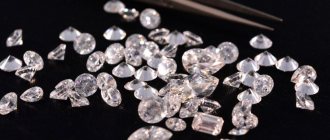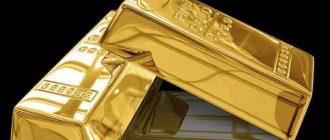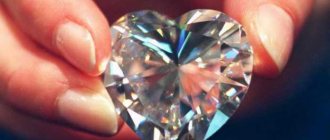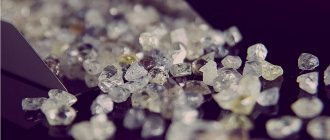It is impossible to tell everything about diamonds. These unusual stones have a very long, and often almost detective, history. A diamond is a future diamond, the salvation of someone’s life in the hands of a skilled surgeon, an irreplaceable tiny part in a very important device. All this and much more is a diamond.
Many famous minerals have left mystical traces in the history of precious jewelry. Let's try to find out what this amazing stone is in this article.
History of the discovery of diamond
Rough diamonds.
Photo: annamoltkehuitfeldt.wordpress.com The exact time of the discovery of the diamond has not yet been established. The thing is that the appearance of unprocessed minerals is quite trivial and does not attract much attention. The first mentions of Indian stones date back to the 3rd millennium BC, but they began to be used in jewelry only about 500 years ago, after craftsmen mastered diamond cutting methods. Advertising - Continued below
In Russia, Catherine II had a special love for them; during her reign, the concept of a diamond came into use as a synonym for wealth and luxury.
The name of the mineral in different languages has a similar sound and meaning. The Arabs called it “almas”, that is, “the hardest”, the Greeks called it “adamas”, which means “indestructible”. The Russian word “diamond” was introduced into circulation in the middle of the 15th century by the traveler Afanasy Nikitin in the book “Walking across Three Seas.”
Production
For centuries, diamonds were mined primarily by hand, from placers of other rocks, and often from river sediments. Therefore, scientists believed that the formation of these stones depended on river flow. But in the middle of the 19th century, kimberlite pipes were discovered - peculiar “abscesses” on the body of the planet, consisting of frozen igneous rocks.
A kimberlite pipe is a consequence of an underground volcanic explosion, the shortest path along which the blast wave, magma and accompanying gases sought their way to the surface. It is filled with a special rock - kimberlite, which is a “salad” of various stones, minerals and the like melted and mixed with each other
. In the pipe you can find traces of one and a half thousand different natural substances, up to 10% of which are diamond-bearing rocks.
Diamond in the Rough
The name itself comes from the place name of Kimberley, a small village in South Africa where the pipes - and the diamonds in them - were first discovered. Subsequently, diamond deposits were discovered throughout the planet, with the exception of the South Pole, but large mining areas are rare.
The main centers of diamond mining are the Republic of Sakha (Yakutia) in the Russian Federation, the states of South Africa, Namibia and Botswana in South Africa, the states of Minas Gerais and Bahia in Brazil. Adamants are also found in Kazakhstan, Australia, the USA, Canada and India, but Indian deposits are almost depleted.
70% of the world diamond market - mining, cutting, first sales - is controlled by 3 largest companies, natural monopolists: De Beers in Africa, ALROSA in Russia and Rio Tinto in Brazil. The cost of diamonds is largely determined by the prices set by the main suppliers.
Physicochemical properties of diamond
Yakut rough diamonds
Diamonds are transparent, colorless minerals, less often they have pink and yellow shades, they have a bright shine and high refractive indexes.
Advertising - Continued below
The mineral consists of carbon atoms equidistant from each other at a distance of 0.15 nanometers. The atoms form a cubic crystal lattice, giving diamond the highest hardness on the Mohs scale—10. However, due to perfect cleavage, crystals are very fragile, and the erroneous identification of the concepts of hardness and fragility often led to the destruction of valuable stones.
This is how the collection of diamonds of the French Duke Charles the Bold, who waged an internecine war with the king, was destroyed. The mercenaries of Louis XI, wanting to test the authenticity of the stones with a hammer, turned them into powder.
STRUCTURE
Crystal structure of diamond
Diamond system is cubic, space group Fd3m. The elementary cell of the diamond crystal lattice is a face-centered cube, in which carbon atoms are located in four sectors arranged in a checkerboard pattern. Otherwise, the diamond structure can be represented as two cubic face-centered lattices, offset relative to each other along the main diagonal of the cube by a quarter of its length. A structure similar to diamond is found in silicon, a low-temperature modification of tin and some other simple substances. Diamond crystals always contain various defects in the crystal structure (point, linear defects, inclusions, subgrain boundaries, etc.). Such defects largely determine the physical properties of crystals.
Diamond formation and deposits
“Mir” kimberlite pipe 525 meters deep
It’s hard to believe, but diamond and graphite are practically twin brothers. Both are pure carbon. In order for graphite to crystallize, special conditions are required: a pressure of 45,000−60,000 atmospheres and a temperature of 900−1300 °C, which are provided at a depth of 80−150 km underground. Together with volcanic magma, stones are ejected from the bowels of the earth, forming primary deposits - kimberlite pipes.
Advertising - Continued below
Scientists also know minerals of meteorite origin, formed during the collision of a cosmic body with the surface of the Earth. The temperature at the moment of impact reaches 3000 °C, and the pressure reaches 100 GPa; under these conditions, diamond-bearing impact rock is formed. “Unearthly” stones were discovered in the Grand Canyon in the USA in fragments of a meteorite that fell about 30 thousand years ago. Yakutia also has its own similar deposit - the Popigai astrobleme, formed 35 million years ago.
The development of impactites is unprofitable due to the small size of the crystals, so industrial mining is carried out using traditional methods in “terrestrial” deposits, which are found on almost all continents, and the largest are located in South America (Brazil), Russia (Yakutia), Africa (Botswana, Angola).
How to distinguish from a fake
Diamond is often counterfeited. Instead of a diamond, they can slip in a synthetic cubic zirconia stone or even glass.
A popular imitation of diamonds is Swarovski rhinestones made of acrylic and glass.
Sometimes they try to sell colorless transparent stones (quartz, zircon, topaz) under the guise of a diamond. Some of these colorless minerals can also cut glass. Therefore, it is better to entrust the authenticity of diamonds to professional appraisers: they can determine the thermal conductivity of the stone or draw a line along it with a special felt-tip pen. The trace from it on the surface of the diamond is even, but on another mineral or glass the line will be dotted.
You can take a magnifying glass with 12x magnification to the store and look through it in bright light. Cubic zirconia will exhibit the optical effect of doubling the facets, while diamond does not have this effect.
Artificial diamonds
Scientific experiments on creating artificial diamonds began in 1797, but the first mineral grown in the laboratory and the method for its production were patented by the American company General Electric only in 1956. Since then, technology has advanced so far that today many artificially grown stones are completely indistinguishable from natural ones without special equipment and extensive experience, and conventional methods of recognizing a fake do not always work.
Advertising - Continued below
However, the saturation of the market with such stones is restrained by the law of supply and demand, since the fall in prices for diamonds is unprofitable for either miners of natural or artificial stones.
Known analogues of natural diamonds
It is worth mentioning the most common stones that are used in jewelry instead of diamonds. Firstly, these are well-known cubic zirconias, first synthesized at the Russian Institute of Lebedev Physical Institute. Secondly, these are moissanites, which are especially difficult to distinguish from a real gemstone without the necessary knowledge.
Rough comparison of natural diamond, moissanite and cubic zirconia
In addition, relatively recently, ASHA diamonds have appeared, the surface of which is covered with a layer of carbon atoms (of which the natural mineral is composed), which actually makes such a stone a composite material and at the same time gives it more shine and “fire” compared to the same cubic zirconias.
Advertising - Continued below
Special mention should be made of HPHT (high pressure, high temperature) diamonds. This method was developed in the 1950s and the resulting stones are actually completely natural.
The essence of the method is not difficult to understand if you remember the conditions for the formation of the stone. In nature, diamond is formed under the influence of colossal pressure and temperature over a certain period of time. Sometimes such stones reach the surface ahead of time, essentially representing a “semi-finished product.” And in order to turn it into a beautiful sparkling diamond, which will later be cut and inlaid, the stone is repeatedly exposed to high pressure and high temperature, similar to natural ones, but in the laboratory. Such a diamond remains completely natural, but as if “modified” by people.
A visual comparison of a real diamond (in the center) with its analogues: 1 - cubic zirconia, 2 - moissanite, 3 - ASHA diamond, 4 - laboratory-grown diamond
AREAS OF USE
Application in science and technology
Due to its unique properties and features, diamond is used:
- in medicine - for the manufacture of instruments for microsurgery,
- in drilling technology - for the production of heavy-duty drills,
- in the production of tools - for processing metals and alloys.
We recommend: EMERALD gemstone
High-pressure apparatus, the stone-cutting industry, electronic devices, physics - all this will simply stop without a unique stone.
The magical properties of diamond
- People have accumulated a lot of observations, beliefs, and superstitions associated with amazing stones.
- The Indians were the first to understand the beauty of the stone, define its magic, and consider the diamond a symbol of the purity of the soul.
- The properties of diamonds were described and used by astrologers, priests, sages, scientists...
Here are a few of the properties attributed to stones of amazing beauty and strength:
- Strengthens strength, makes the properties inherent in the owner stronger and brighter. It should be noted that all properties are both good and bad.
- Protects against the evil eye, astral attacks, and evil witchcraft.
- It will cleanse the room from negative energy, from larvae, from any evil entities. Provided there are no other gems in the room.
- A stone worn on the left hand will help defeat enemies.
- Protects pregnant women and women in labor.
- Worn by a criminal, the stone will act against the owner.
Adamant will only work if it was given to the owner as a gift.
A stone bought for oneself, stolen, or dubiously obtained resists fiercely.
Who is suitable according to their zodiac sign?
Suitable for everyone, if only you had the money to buy it. Diamond in the horoscope is patronized by the Sun and Venus. Since the sun is present in every person's natal chart, this sparkling miracle is suitable for everyone (but with reservations).
- Adamant's first favorites are Leos. They, the kings of the horoscope, should rightfully wear the royal stone.
- Aries, in whose veins molten fire flows, will be successfully helped in life by a red or pink diamond.
The astrological meaning of a diamond is a combination of natural elements, Earth and Water, Fire and Air.
Indian astrologers believe that diamond jewelry should be worn for the first time on Friday, the day of Venus.
Magical and healing properties of diamond
Lithotherapists believe that diamond accelerates the renewal of body cells, promotes cleansing, and fights infections and parasites. In many teachings it is used as a rejuvenating agent.
Advertising - Continued below
Yogis use diamond to treat mental illness, heart, kidneys, and cleanse the liver. Warriors wore diamond rings, believing that it would give them fortitude and make them invincible. In addition, the stone brings happiness to the owner and protects against bad habits and actions.
Compatibility with other stones
Diamond is the real king of gems - dazzling and powerful, luxurious and expensive. It does not tolerate proximity to semi-precious and ornamental stones. The best company for him is jewelry of approximately equal value, but not all. Stones belonging to the element of water are excluded - these are emerald, chrysoberyl, aquamarine, opal, selenite, coral and other gems. The rule does not apply only to pearls.
The best combination is between diamonds and rubies and pyropes, as they complement each other both aesthetically and energetically.
Blue Diamond
The combination of water-air sapphire and fire diamond is ambiguous; the consequences of such a combination are difficult to predict.
Gems belonging to the element of earth (jade, onyx, lapis lazuli, jasper, malachite, turquoise, obsidian, aventurine, cacholong) are extremely rarely combined with diamonds due to their low cost, and also because fire suppresses their energy.
For the same reasons, esotericists do not recommend wearing diamonds and air stones at the same time - amethyst, rock crystal, chrysoprase, carnelian, agate and others.
Who will benefit from diamonds and diamonds?
Graff yellow diamond necklace with 132 carat Golden Empress center diamond
Ring Tiffany & Co. with colorless diamonds and a blue diamond in the center
Diamond, like diamond, is the stone of the brave and determined. It requires a respectful attitude and may be useless in the hands of a weak, insecure person.
Best time to buy
The most favorable time to buy a diamond is the 15th lunar day . It is recommended to wear jewelry with it for the first time on 29–30 lunar days .
It’s good if the 15th lunar day falls on Saturday or Sunday and if it is sunny .
If you want to purchase a diamond as a talisman or amulet, it is better to take a loved one with you to the store, who will buy it for you and say the phrase: “I give you this ring” (or another thing). After this, the stone in 2 weeks .
Where is it used?
The scope of use of diamonds in jewelry is wide: these precious stones, after appropriate processing, are used for any jewelry. A rough diamond, even a black or “bloody” one, is practically unsuitable for setting. The frame is used exclusively in yellow and white gold or platinum.
There are many types of stone cuts. The classic one has 57 facets and provides the most vivid “game” of the stone. Not always applicable: many small crystals cannot be cut this way. They use a simplified rose cut, in the form of an ellipse or pear. The type of cut is selected depending on the size and shape of the raw crystal.
Jewelry with diamond
There is a differentiation of professional cutters in the world: in the East - in India, Thailand and China they work with small stones, up to 0.3 carats; Russia and Belgium produce medium and large diamonds; in the USA only large ones are produced.
